In the heart of the City of Light, where the Seine’s gentle currents caress the history-laden banks, stands an architectural marvel that transcends time. The Arc de Triomphe in Paris, an iconic masterpiece, beckons visitors to immerse themselves in its storied past and sweeping vistas that whisper tales of a bygone era.
As you ascend the spiraling staircase, you’ll embark on a journey through the annals of French history, guided by the towering arch that stands as a testament to resilience and remembrance.
The History of the Arc de Triomphe
Birth from Triumph and Turmoil
The Arc de Triomphe was commissioned in 1806, following Napoléon’s victory at Austerlitz. This triumph marked a zenith in the French military’s tactical supremacy, a brief moment of glory that would be eclipsed by subsequent tumultuous events. Within a decade, Napoléon’s empire crumbled, and his ambitions dissolved like morning mist.
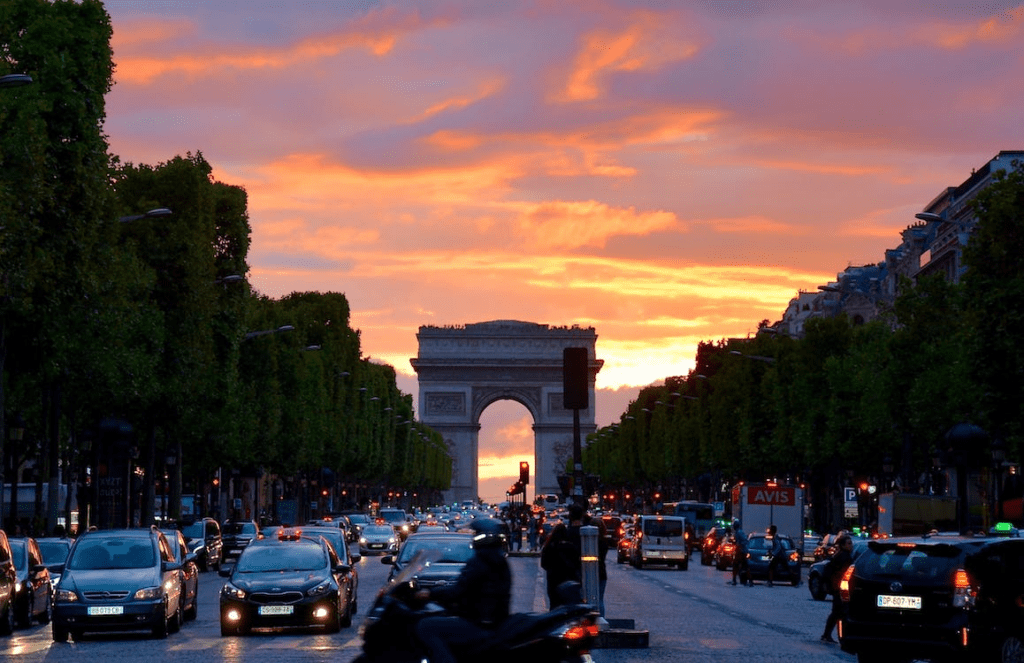
A Monument of Endurance
Construction of the arch spanned decades, and it wasn’t until 1836 that the project reached its culmination. In 1840, Napoléon’s remains were borne beneath the arch to their final resting place at Invalides. A poignant end to a tumultuous era.
Beneath the Arch: Where History Beckons
The Tomb of the Unknown Soldier
Beneath the arch at ground level lies the Tomb of the Unknown Soldier. Honouring the 1.3 million French soldiers who lost their lives in WWI, the Unknown Soldier was laid to rest in 1921, beneath an eternal flame that is rekindled daily at 6.30 pm.
Bronze Plaques of Historical Significance
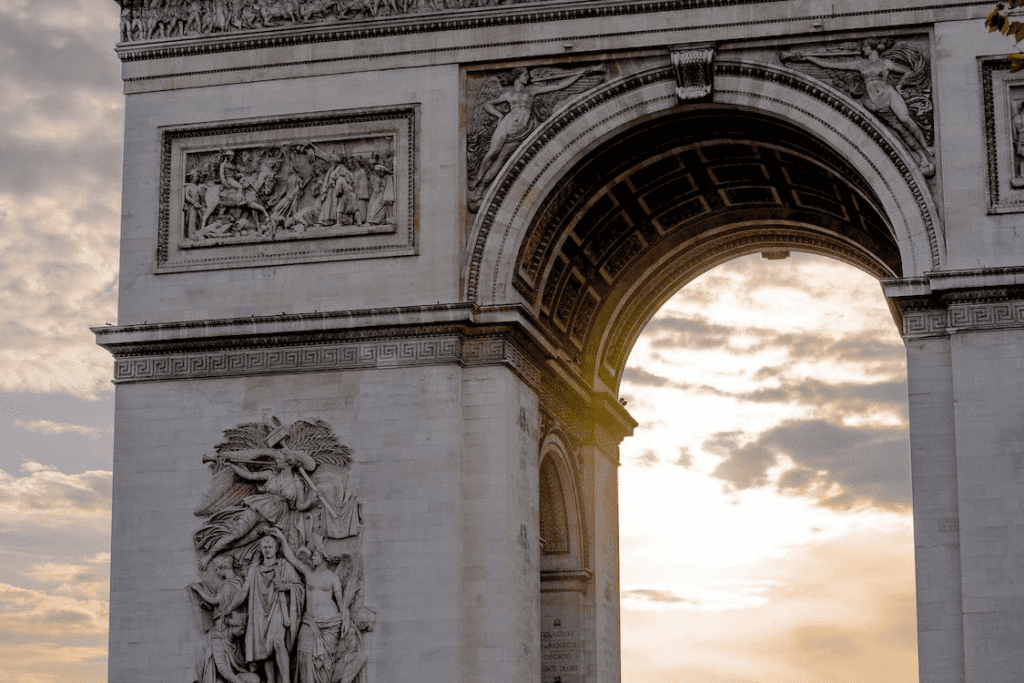
As you explore the ground beneath the arch, you’ll encounter bronze plaques that chronicle pivotal moments in modern French history. Each one is a testament to resilience, from the proclamation of the Third French Republic in 1870 to the triumphant return of Alsace and Lorraine to French rule in 1918. One plaque, perhaps the most poignant, bears the words from Charles de Gaulle’s historic London broadcast on June 18, 1940.
The Sculptures: Chronicles in Stone
La Marseillaise by François Rude
The arch is adorned with four main sculptures, six panels in relief, and a frieze running beneath the top. The most striking sculpture, “La Marseillaise,” sculpted by François Rude, captures a moment of hope as soldiers of all ages gather beneath the wings of victory, uniting to repel invading armies.
Historical Reliefs
Higher panels immortalize crucial victories of the Revolutionary and imperial French armies, each etched in stone. The frieze, a tapestry of history, is divided into two parts: the Departure of the Armies and the Return of the Armies.

Hidden Museum within the Arch
Beneath the viewing platform, an enlightening multimedia section unravels the historical tapestry, providing deeper insights into the intricate symbolism.
Viewing Platform: Paris at Your Feet
Ascend to the Summit
Climb the 284 steps to the viewing platform at the top of the 50m-high arch, and you’ll be suitably rewarded with magnificent panoramas over western Paris.
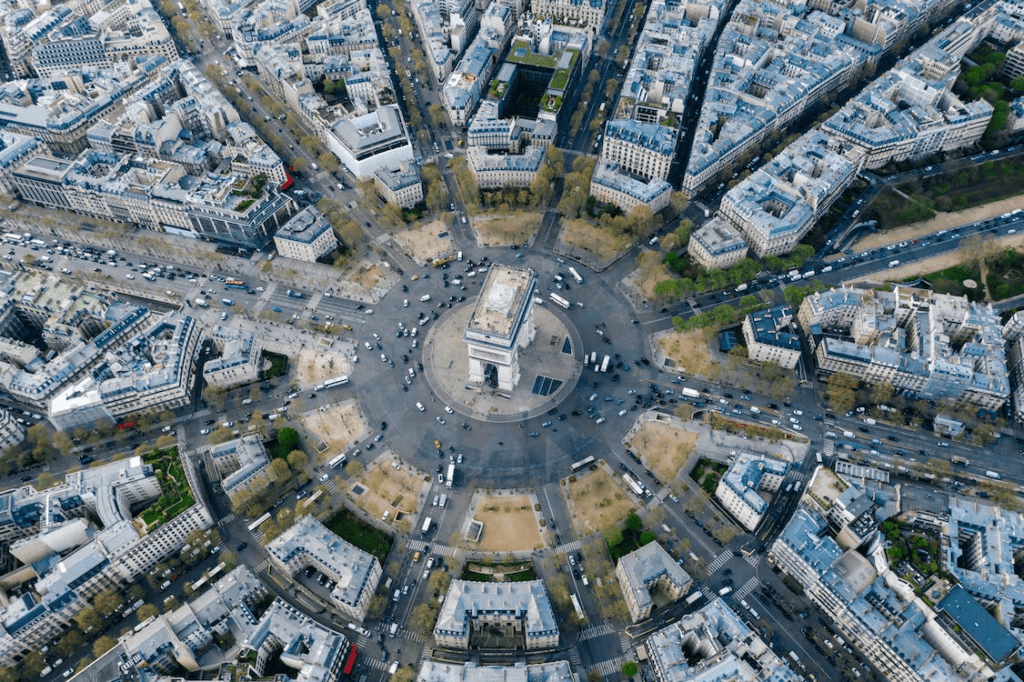
A Panoramic Experience
From this summit, the city unfolds beneath you like a treasured map. A dozen broad avenues, named in homage to Napoléon’s victories and illustrious generals, radiate in every direction.
The Museum of The Arc de Triomphe: A Hidden Gem
Most people don’t know it, but the Arc de Triomphe hides a small museum within its walls. Original documents, photographs, and artistic creations narrate the history of the Arc, offering a deeper understanding of its evolution into an enduring symbol of France.
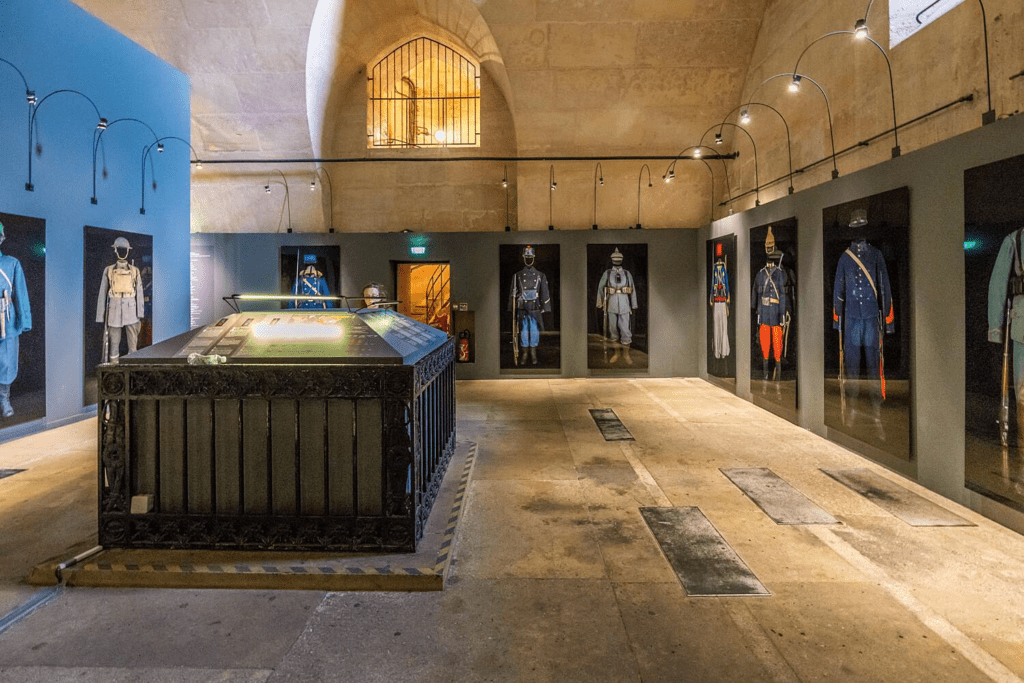
Champs-Élysées: A Stroll Through Elegance
Strolling down the Champs-Élysées from the Arc de Triomphe will leave you in the museum-rich neighborhood surrounding the unparalleled vistas of Place de la Concorde. Explore the neighboring district’s architectural gems, from the Grand Palais to the Petit Palais, and from the Palais de la Découverte to the Église de la Madeleine, a neoclassical marvel.
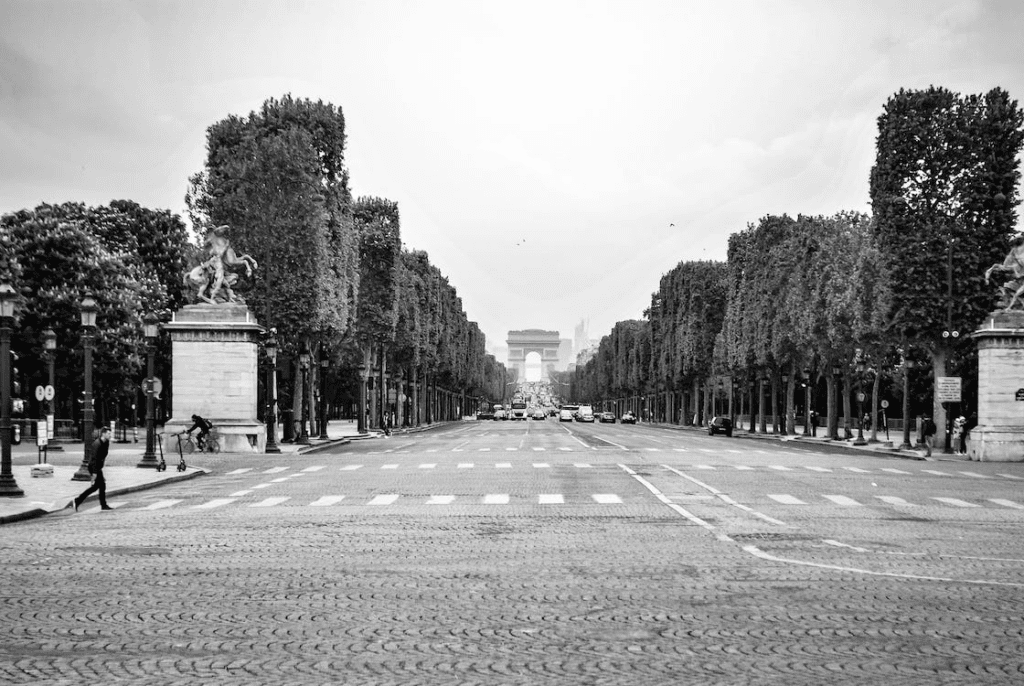
Cultural Treasures
As you follow this urban tapestry, you’ll discover the Palais Garnier, Paris’s iconic 19th-century opera house, a treasure trove of cultural significance.
The 5 Most Popular Things to Do at the Arc de Triomphe
View All of Paris from the Arc’s Rooftop Terrace
Capture the city’s essence in a single gaze and watch as the Eiffel Tower comes alive with sparkling brilliance.
Check Out the Arc’s Inscriptions & Decorations
Immerse yourself in the intricate bas-relief carvings and inscriptions that tell the tale of 158 major battles fought between 1792 and 1815.

Pay Your Respects at the Tomb of the Unknown Soldier
Honor the memory of all French soldiers who fell during World War I. The eternal flame, “Flame of Remembrance,” burns brightly, keeping their legacy alive.
Admire the Arc de Triomphe from a Car-Free Champs Élysées
On select occasions, embrace the magic of a car-free Champs Élysées and revel in the breathtaking view of the Arc de Triomphe.
View the Arc de Triomphe from the Grande Arche
Explore an even grander arch, the Grande Arche, in La Défense, and witness a different perspective of Paris.
Best Time to Visit the Arc de Triomphe
To relish the Arc de Triomphe in tranquility, visit early in the morning or late afternoon. Sunset, however, transforms the city into a spectacle of lights and shadows. Avoid the peak tourist seasons and opt for spring or fall for milder crowds and pleasant weather. Weekdays are also less crowded than weekends.

Pro Tips for Visiting Arc de Triomphe in Paris
- Don’t cross the traffic circle above ground; use the pedestrian tunnels to access the arch.
- Tickets can be purchased online to avoid long queues.
- Elevator access is available for visitors with limited mobility and families with young children.
Arc de Triomphe Opening Hours (2024)
Visiting Hours: The Arc de Triomphe welcomes visitors every day, except on major holidays. The schedule is as follows:
- October 1 – March 31: 10:00 am – 10:30 pm
- April 1 – September 30: 10:00 am – 11:00 pm
Please note: last access to the monument is 45 minutes before closing time.
Tickets for Arc de Triomphe (2024)
Entry Fees: Visitors can explore the first floor of the Arc de Triomphe without any cost. However, if you wish to delve deeper into the arch’s history or ascend its 284 steps to reach the top observation deck, there is an entry fee of approximately €16 (around $17,25).
- EU Visitors Under 25: Young visitors under the age of 25 from European Union countries enjoy free admission.
- Paris Museum Pass: Holders of a Paris Museum Pass can also enter for free.
- Guided Tours: Guided tours are available for around $25, which is not covered by the museum pass.
Arc de Triomphe Official Website
For official information, tickets, and guided tour bookings, you can visit the Arc de Triomphe’s official website. It’s the best place to get the most up-to-date details regarding your visit.
How to Get There: Metro «Charles de Gaulle–Étoile»
No less than 12 major avenues lead to the Arc, including the Champs Elysées, Avenue Foch, and Avenue de la Grande Armée. The most convenient way to arrive is by subway, which takes you directly to the base of the arch. Access is available through a pedestrian underground passage from Avenues Champs Elysees and Grand Armée.
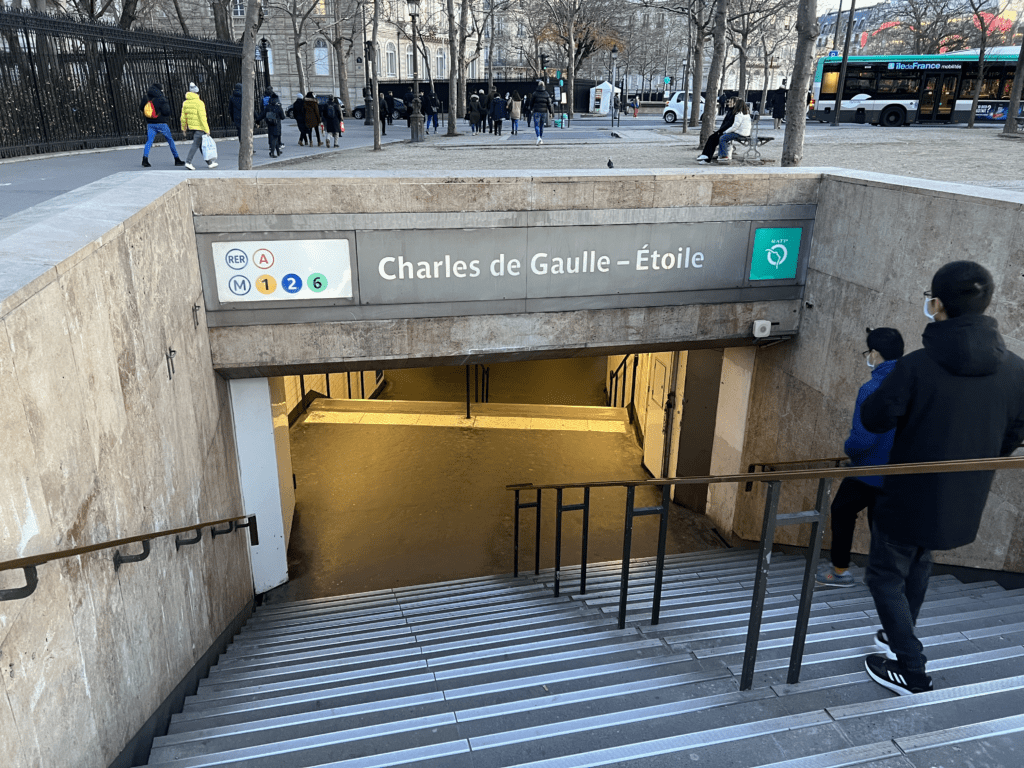
Getting to the Iconic Arc de Triomphe by Metro, RER and Bus
- By Metro: The metro is one of the most efficient ways to reach the Arc de Triomphe. Simply take lines 1, 2, or 6 and disembark at the Charles de Gaulle-Étoile station. Follow Exit 1, signposted as “Arc de Triomphe,” and you’ll emerge right at the base of this iconic monument.
- With the RER: For those arriving via the RER, hop on line A and get off at the Charles de Gaulle-Étoile station. Once you exit, head to Exit 1, where you’ll be greeted by the grandeur of the Arc de Triomphe.
- By Bus: Paris boasts an extensive bus network that makes reaching the Arc de Triomphe a breeze. Simply board one of the following bus lines: 1, 2, 22, 30, 31, 73, or 92. Make sure to check for bus stops whose names begin with “Charles de Gaulle – Étoile,” and you’ll find yourself conveniently close to this historic landmark.
How Long to Spend at Arc de Triomphe
The amount of time you spend at the Arc de Triomphe depends on your interests and the crowds. To fully appreciate the arch’s history and the stunning views from the rooftop terrace, it’s advisable to allocate at least a couple of hours to your visit. However, you can certainly enjoy a quicker visit as well. Sunset is a popular time to visit for the scenic views, but it tends to be busier during this time.
Conclusion: A Monument Beyond Time
As you stand atop the Arc de Triomphe, time dissipates, and history unfolds beneath your gaze. The Arc de Triomphe is not just a monument; it is the heart of a nation, the soul of a city, and a symbol that transcends time.
Come, stand at the pinnacle of history, and watch as the lights of Paris twinkle to life, revealing a tapestry of stories etched in stone, a testament to the indomitable spirit of the French people. Paris invites you to immerse yourself in its timeless embrace, and the Arc de Triomphe is your gateway to this enchanting world.
Frequently Asked Questions About the Arc de Triomphe
Do you need tickets to the Arc de Triomphe?
Visitors can explore the first floor of the Arc de Triomphe without purchasing tickets. However, if you wish to enter the arch and ascend its 280 steps to the top observation deck, an entry fee of approximately €13 is required.
How much are Arc de Triomphe tickets?
The ticket price for the Arc de Triomphe is approximately €13 for adults. Keep in mind that members of the European Union under the age of 25 can enter for free, as can tourists with a Paris Museum Pass.
Is the Arc de Triomphe free for those under 25?
Yes, individuals under the age of 25 who are part of the European Union can visit the Arc de Triomphe for free.
How much is it to go to the Arc de Triomphe roof?
To reach the rooftop of the Arc de Triomphe, you will need to pay the standard entry fee, which is approximately €13 for adults.
Can you skip the line at the Arc de Triomphe?
While there is no specific mention of skipping the line, purchasing tickets online in advance can help you avoid the crowded ticket window, ensuring a smoother entry.
What time is best for the Arc de Triomphe?
For the best experience, consider visiting the Arc de Triomphe during the early morning or late afternoon to avoid crowds. Sunset is also a spectacular time to appreciate the monument and enjoy the stunning views.
Can you buy tickets on the day to go up the Arc de Triomphe?
Yes, you can purchase tickets on the day of your visit to go up the Arc de Triomphe. However, booking them online in advance is a recommended option to save time.
How long can you spend at the Arc de Triomphe?
Visiting the entire Arc de Triomphe, including the rooftop, and taking some memorable photographs typically takes around 45 minutes to 1.5 hours.
What time does the Arc de Triomphe light up?
Every evening at 6:30 PM, an eternal flame is rekindled by war veterans beneath the Arc de Triomphe. This is a solemn and poignant event that you can witness during your visit.
What is the Arc de Triomphe famous for?
The Arc de Triomphe is famous for its historical significance as a symbol of French patriotism and military victory. It honors those who fought and died for France during the French Revolutionary and Napoleonic Wars.
Can I visit the Arc de Triomphe for free?
Yes, visitors under the age of 25 who are part of the European Union can enter the Arc de Triomphe for free. However, there is an entry fee for other visitors.
Is it worth going up the Arc de Triomphe?
Absolutely, ascending the Arc de Triomphe provides breathtaking panoramic views of Paris, making it a worthwhile experience for those seeking stunning vistas of the city.
Why is Champs-Élysées famous?
The Champs-Élysées is famous for its historic and cultural significance. It’s a renowned avenue lined with theaters, cafés, luxury shops, and landmarks, and it has been a central location for celebrations and parades in France.
What is the famous circle in Paris?
The famous circle in Paris is the Place Charles de Gaulle, also known as the Étoile, which surrounds the Arc de Triomphe. It’s a major traffic hub and a prominent location in the city.
Is it better to visit the Arc de Triomphe during the day or at night?
Visiting the Arc de Triomphe during both the day and night offers unique experiences. During the day, you can appreciate the architectural details, and at night, you can witness the monument illuminated and enjoy the city’s lights.
Can you see the Eiffel Tower from the top of the Arc de Triomphe?
Yes, from the top of the Arc de Triomphe, you can enjoy stunning views of Paris, including the iconic Eiffel Tower. It’s one of the best vantage points to capture this famous landmark from a height.
